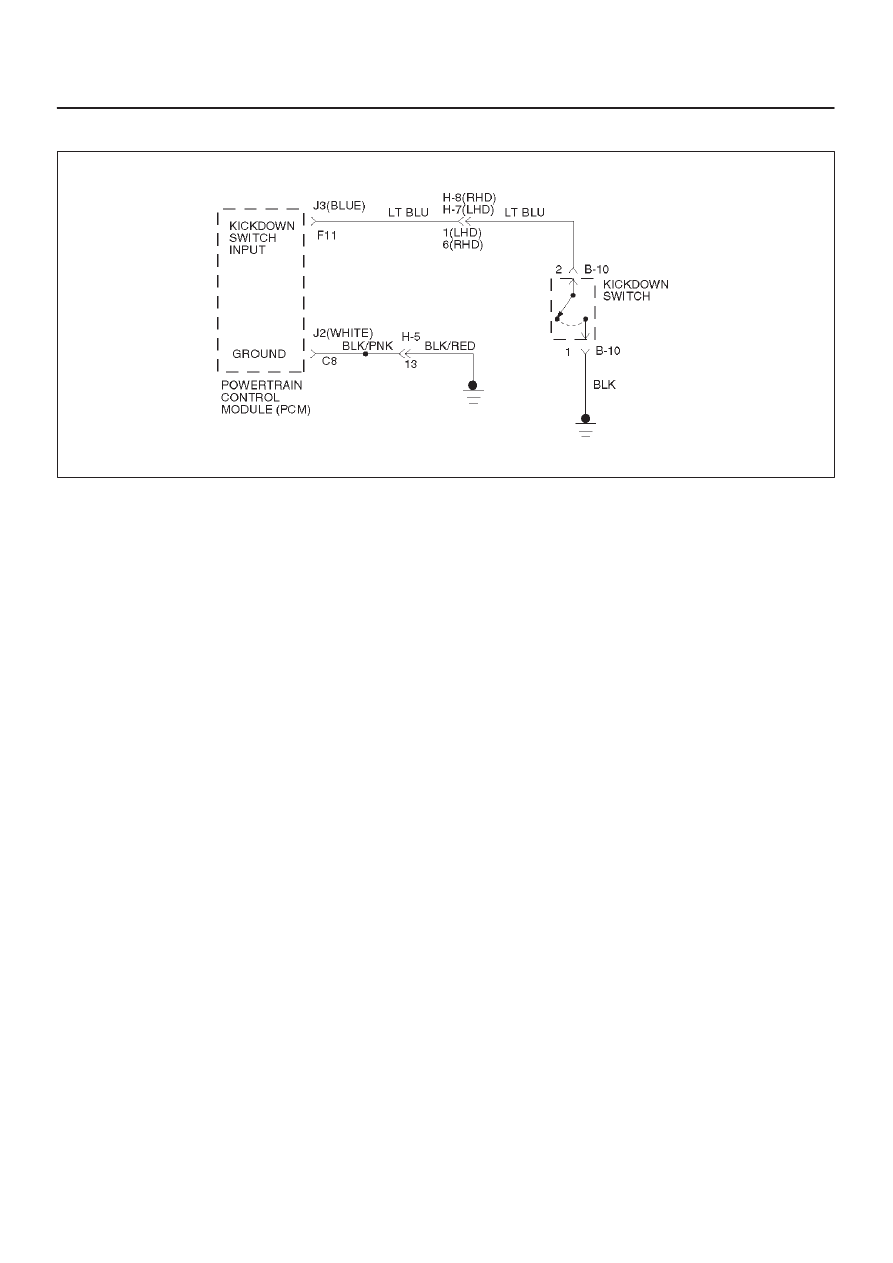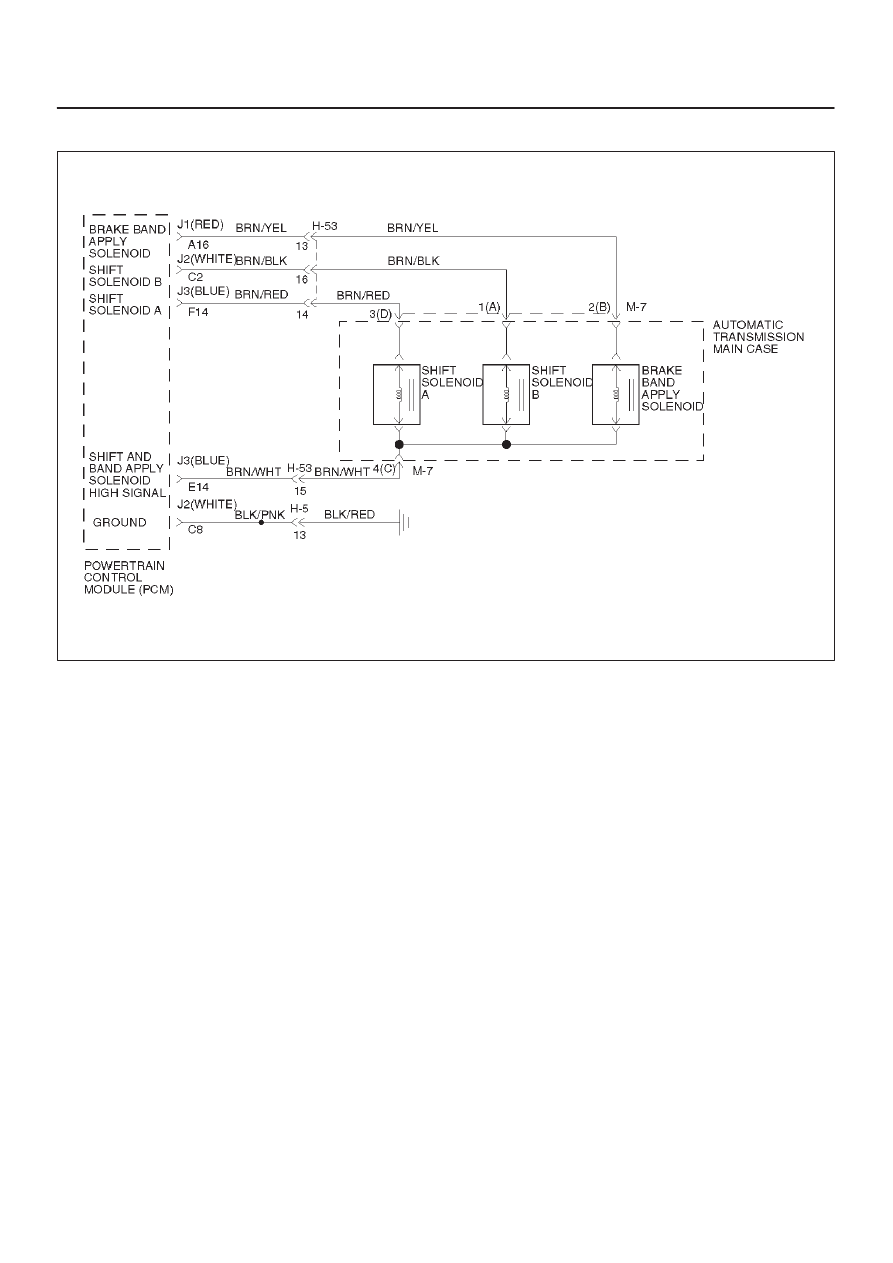Opel Frontera UBS. Service manual — part 1509

7A1–66 TRANSMISSION CONTROL SYSTEM (4L30–E)
DTC P1792 EEPROM Transmission
Side Bad Check Sum
Circuit Description
Transmission Side Read Only Memory (ROM) and
Electronically Erasable Programmable Read Only
Memory (EEPROM) is an electronic circuit that controls
the transmission control in the Powertrain Control Module
(PCM).
This DTC detects a check sum error. This is a type “C”
DTC.
Conditions For Setting The DTC
D
Detects check sum error for 1 second.
Action Taken When The DTC Sets
D
Maximum line pressure.
D
Immediate landing to 4th gear.
D
Inhibit TCC engagement.
D
The PCM will illuminate the CHECK TRANS Lamp.
Conditions For Clearing The DTC/CHECK
TRANS Lamp
D
The PCM will turn off the CHECK TRANS Lamp after
three consecutive ignition cycles without a failure
reported.
D
The DTC can be cleared from the PCM history by
using a scan tool.
D
The DTC will be cleared from history when the vehicle
has achieved 40 warmup cycles without a failure
reported.
D
The PCM will cancel the DTC default actions when
the fault no longer exists and the ignition is cycled “off”
long enough to power down the PCM.
DTC P1792 EEPROM Transmission Side Check Bad Check Sum
Step
Action
Yes
No
1
1. Install the scan tool.
2. With the engine “off”, turn the ignition switch “on”.
NOTE: Before clearing DTC(s), use the scan tool to record “Failure
Records” for reference, as data will be lost when the “Clear Info”
function is used.
3. Record the DTC “Failure Records”.
Was DTC P1790 set?
Go to Step 4
Go to Step 2
2
Was DTC P1792 set?
Go to Step 3
—
3
1. Remove the PCM. Refer to Powertrain Control Module (PCM)
in Automatic Transmission (4L30–E) section.
2. Using the ITCS, make a reprogramming the transmission
EEPROM.
Was the reprogramming complete?
Go to Step 5
—
4
Replace the PCM.
Is the replacement complete?
Go to Step 5
—
5
1. After the repair is complete, use the scan tool to select “DTC”,
then “Clear Info” function and operate the vehicle.
2. Review the scan tool “DTC Info”.
Has the last test failed or is the current DTC displayed?
Begin diagnosis
again
Go to Step 1
Repair verified
Exit DTC table

TRANSMISSION CONTROL SYSTEM (4L30–E)
7A1–67
DTC P1835 Kickdown Switch Always On
D07RW033
Circuit Description
D
When the driver presses the accelerator pedal down
fully, the kickdown switch closes, sending a ground
signal to the Powertrain Control Module (PCM).
D
This information is used to perform shifts at high
engine speed.
D
When the kickdown switch is closed, the Throttle
Position Sensor (TPS) is already is at 100%.
D
This DTC detects a closed kickdown switch when TP
angle is less than 70%.
D
This is a type “D” DTC.
Conditions For Setting The DTC
D
No TPS DTCs P0122 or P0123.
D
TP angle is less than 70%.
D
Kickdown switch is “on”.
D
All conditions met for 1 second.
Action Taken When The DTC Sets.
D
Kickdown mode control is off.
D
The PCM will not illuminate the CHECK TRANS
Lamp.
Conditions For Clearing The DTC
D
The DTC can be cleared from the PCM history by
using a scan tool.
D
The DTC will be cleared from history when the vehicle
has achieved 40 warmup cycles without a failure
reported.
D
The PCM will cancel the DTC default actions when
the fault no longer exists and the ignition is cycled “off”
long enough to power down the PCM.
Diagnostic Aids
D
Check the wiring harness for a short to ground
between the PCM and kickdown switch.
D
Check the kickdown switch for failure.
D
Check kickdown adjustment.
Test Description
The numbers below refer to the step numbers on the
diagnostic chart:
1. This test checks for short to ground or kickdown
switch failure.
3. This test checks for regulation kickdown switch.

7A1–68 TRANSMISSION CONTROL SYSTEM (4L30–E)
DTC P1835 Kickdown Switch Always On
Step
Action
Yes
No
1
1. Install the scan tool.
2. With the engine “on”, turn the ignition switch “on”.
NOTE: Before clearing DTC(s), use the scan tool to record “Failure
Records” for reference, as data will be lost when the “Clear Info”
function is used.
3. Record the DTC “Failure Records”.
Does the scan tool display “Kickdown switch” “low” (closed
switch)?
Go to Step 2
Go to Step 3
2
1. Turn the ignition “off”.
2. Disconnect the J3 (BLUE) PCM connector.
3. Using the J39200 DVOM, check a continuity between PCM
connector terminal J3–F11 and ground.
Is there a continuity?
Go to Step 4
Go to Step 7
3
The TP angle goes from 0% to 100% with the accelerator pedal
depressed.
Is the kickdown switch “on” when TP angle is below 70%?
Go to Step 5
Go to Diagnostic
Aids
4
1. Disconnect the kickdown switch connector B–10.
2. Using the J39200 DVOM, check a continuity between
terminals B10–1 and B10–2.
Is there a continuity?
Go to Step 6
Go to Step 8
5
Adjust the kickdown switch.
Is the kickdown switch “on” when TP angle is above 95%?
Go to Step 9
—
6
Replace the kickdown switch.
Is the replacement complete?
Go to Step 9
—
7
Replace the PCM. Refer to Powertrain Control Module (PCM) in
Automatic Transmission (4L30–E) section.
Is the replacement complete?
Go to Step 9
—
8
Repair the short to ground in circuit LT BLUE.
Is the repair complete?
Go to Step 9
—
9
1. After the repair is complete, use the scan tool to select “DTC”,
then “Clear Info” function and ensure the following condition is
met:
The torque converter stator temperature switch circuit does not
indicate a hot mode when the transmission fluid temperature is
less than 60
°
C (140
°
F) for at least 5 seconds.
2. Review the scan tool “DTC Info”.
Has the last test failed or is the current DTC displayed?
Begin diagnosis
again
Go to Step 1
Repair verified
Exit DTC table

TRANSMISSION CONTROL SYSTEM (4L30–E)
7A1–69
DTC P1850 Brake Band Apply Solenoid Malfunction
D07RW009
Circuit Description
D
The brake band apply solenoid is a normally open
solenoid which controls the flow of fluid for brake band
application. The Powertrain Control Module (PCM)
uses Pulse Width Modulation (PWM) and changes
the duty cycle to control the solenoid. The PCM turns
the solenoid on (energized) and off (deenergized) at a
constant frequency. The length of time the solenoid is
energized during each on/off cycle is called the pulse
width. By varying or “modulating” the pulse width, the
solenoid output pressure is changed. Since the
solenoid is normally open, increasing the pulse width
increases the duty cycle and decreases the output
pressure. PWM control provides smooth band
application without an accumulator. The band is only
applied in first and second gears.
D
In the event of an electrical failure (open), the
solenoid regulates at the maximum oil flow (0% duty
cycle).
D
The solenoid is activated by current. This current is
produced by applying a voltage to one side (the High
side) and a ground to the other side (Low side).
D
The High Side Driver (HSD) is a circuit of the PCM
that acts as a switch between the solenoids and the
supply voltage. The High side of the solenoid is
permanently supplied with voltage. When the ignition
is off, the HSD is turned off.
This DTC detects a continuous open or short to ground in
the brake band apply solenoid circuit or the brake band
apply solenoid. This is a type “D” DTC.
Conditions For Setting The DTC
D
Battery voltage is between 10 and 16 volts.
D
Ignition is “on”, Engine “run”.
D
The PCM commands the solenoid “on” and the
voltage remains high (B+) or the PCM commands the
solenoid “off” and the voltage remains low (zero
volts).
D
All conditions met in 1.3 seconds.
Action Taken When The DTC Sets
D
Inhibit brake band apply solenoid.
D
The PCM will not illuminate the CHECK TRANS
Lamp.
Conditions For Clearing The DTC
D
The DTC can be cleared from the PCM history by
using a scan tool.
D
The DTC will be cleared from history when the vehicle
has achieved 40 warmup cycles without a failure
reported.
D
The PCM will cancel the DTC default actions when
the fault no longer exists and the ignition is cycled “off”
long enough to power down the PCM.

Нет комментариевНе стесняйтесь поделиться с нами вашим ценным мнением.
Текст